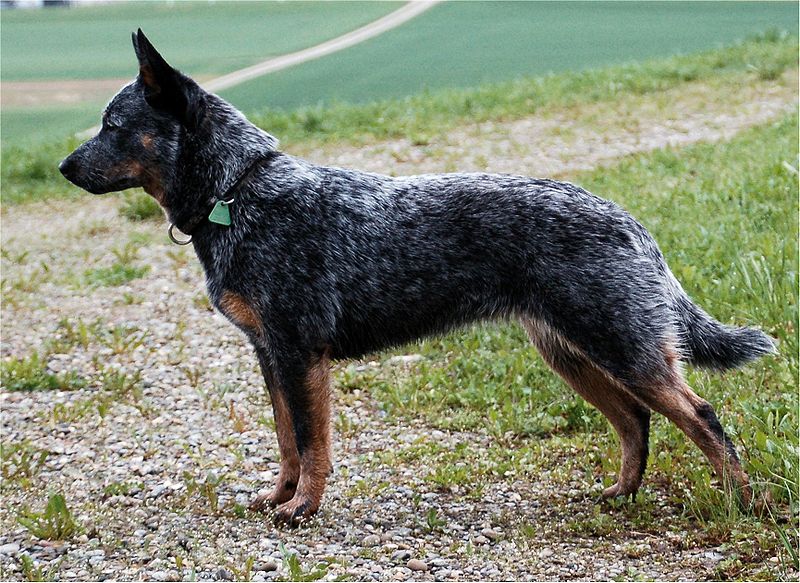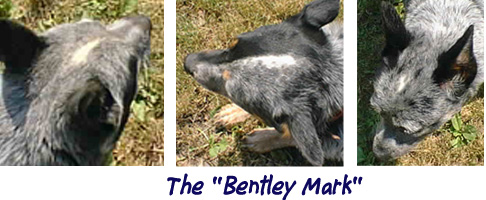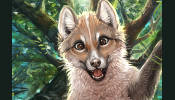is trying to
private chat with you.
The Australian Cattle Dog Support thread
Started By

Australian Cattle Dogs are a hardy, sturdy herding breed with high drive and agility. Also known as "Red Heelers", "Blue Heelers" and "Queensland Heelers" among other names, they are a very loyal, determined, hardworking breed of dog. Highly intelligent, these dogs excel at dog agility, herding, and almost any other dog sport you can think of. They gained the nickname "Heeler" due to their style of herding. Whereas the border collie is herds predominately with their signature "stare", ACDs use a much more "in your face" style of herding, using gentle nips to steer cattle (or whatever they may be herding) in the direction needed.
"Happiest in wide open spaces, ACDs are very high-energy dogs and extremely intelligent, so they need a job – such as herding, obedience or agility – to keep them happy. While wary of strangers, the breed bonds closely to its family, though the owner must establish themselves as the pack leader. Their smooth, short coat requires only occasional baths and brushing."
source: akc.org

ACD Breed Standard
source: akc.org
Appearance: The general appearance is that of a strong compact, symmetrically built working dog, with the ability and willingness to carry out his allotted task however arduous. Its combination of substance, power, balance and hard muscular condition must convey the impression of great agility, strength and endurance. Any tendency to grossness or weediness is a serious fault.
Characteristics: As the name implies the dog's prime function, and one in which he has no peer, is the control and movement of cattle in both wide open and confined areas. Always alert, extremely intelligent, watchful, courageous and trustworthy, with an implicit devotion to duty making it an ideal dog.
Temperament: The Cattle Dog's loyalty and protective instincts make it a self-appointed guardian to the Stockman, his herd and his property. Whilst naturally suspicious of strangers, must be amenable to handling, particularly in the Show ring. Any feature of temperament or structure foreign to a working dog must be regarded as a serious fault.
Head and Skull: The head is strong and must be in balance with other proportions of the dog and in keeping with its general conformation. The broad skull is slightly curved between the ears, flattening to a slight but definite stop. The cheeks muscular, neither coarse nor prominent with the underjaw strong, deep and well developed. The foreface is broad and well filled in under the eyes, tapering gradually to form a medium length, deep, powerful muzzle with the skull and muzzle on parallel planes. The lips are tight and clean. Nose black. Eyes-- The eyes should be of oval shape and medium size, neither prominent nor sunken and must express alertness and intelligence. A warning or suspicious glint is characteristic when approached by strangers. Eye color, dark brown.
Ears: The ears should be of moderate size, preferably small rather than large, broad at the base, muscular, pricked and moderately pointed neither spoon nor bat eared. The ears are set wide apart on the skull, inclining outwards, sensitive in their use and pricked when alert, the leather should be thick in texture and the inside of the ear fairly well furnished with hair. Mouth-- The teeth, sound, strong and evenly spaced, gripping with a scissor-bite, the lower incisors close behind and just touching the upper. As the dog is required to move difficult cattle by heeling or biting, teeth which are sound and strong are very important.
Neck: The neck is extremely strong, muscular, and of medium length broadening to blend into the body and free from throatiness.
Forequarters" The shoulders are strong, sloping, muscular and well angulated to the upper arm and should not be too closely set at the point of the withers. The forelegs have strong, round bone, extending to the feet and should be straight and parallel when viewed from the front, but the pasterns should show flexibility with a slight angle to the forearm when viewed from the side. Although the shoulders are muscular and the bone is strong, loaded shoulders and heavy fronts will hamper correct movement and limit working ability.
Body: The length of the body from the point of the breast bone, in a straight line to the buttocks, is greater than the height at the withers, as 10 is to 9. The topline is level, back strong with ribs well sprung and carried well back not barrel ribbed. The chest is deep, muscular and moderately broad with the loins broad, strong and muscular and the flanks deep. The dog is strongly coupled.
Hindquarters: The hindquarters are broad, strong and muscular. The croup is rather long and sloping, thighs long, broad and well developed, the stifles well turned and the hocks strong and well let down. When viewed from behind, the hind legs, from the hocks to the feet, are straight and placed parallel, neither close nor too wide apart.
Feet: The feet should be round and the toes short, strong, well arched and held close together. The pads are hard and deep, and the nails must be short and strong.
Tail: The set on of tail is moderately low, following the contours of the sloping croup and of length to reach approximately to the hock. At rest it should hang in a very slight curve. During movement or excitement the tail may be raised, but under no circumstances should any part of the tail be carried past a vertical line drawn through the root. The tail should carry a good brush.
Gait/Movement: The action is true, free, supple and tireless and the movement of the shoulders and forelegs is in unison with the powerful thrust of the hindquarters. The capability of quick and sudden movement is essential. Soundness is of paramount importance and stiltiness, loaded or slack shoulders, straight shoulder placement, weakness at elbows, pasterns or feet, straight stifles, cow or bow hocks, must be regarded as serious faults. When trotting the feet tend to come closer together at ground level as speed increases, but when the dog comes to rest he should stand four square.
Coat: The coat is smooth, a double coat with a short dense undercoat. The outer-coat is close, each hair straight, hard, and lying flat, so that it is rain-resisting. Under the body, to behind the legs, the coat is longer and forms near the thigh a mild form of breeching. On the head (including the inside of the ears), to the front of the legs and feet, the hair is short. Along the neck it is longer and thicker. A coat either too long or too short is a fault. As an average, the hairs on the body should be from 2.5 to 4 cms (approx. 1-1.5 ins) in length.
ACCEPTED COLORS

Blue: The color should be blue, blue-mottled or blue speckled with or without other markings. The permissible markings are black, blue or tan markings on the head, evenly distributed for preference. The forelegs tan midway up the legs and extending up the front to breast and throat, with tan on jaws; the hindquarters tan on inside of hindlegs, and inside of thighs, showing down the front of the stifles and broadening out to the outside of the hindlegs from hock to toes. Tan undercoat is permissible on the body providing it does not show through the blue outer coat. Black markings on the body are not desirable.

Red: The color should be of good even red speckle all over, including the undercoat, (neither white nor cream), with or without darker red markings on the head. Even head markings are desirable. Red markings on the body are permissible but not desirable.
NOT RECOGNIZED COLORS
source: hnrworkingkelpies.com

Brown/Chocolate
It has often been said that the ACD only come in two colors --- ticked-black/tan or red. With the help of DNA testing,
this has now proven to be untrue.

An ACD may also be brown, called "chocolate", red (non-extension, e/e, red, instead of sable red) or white. Brown,
red and white are not common colors. The reason these colors are not seen very often is because they are not
actively being bred for, when produced - are not advertised for fear of reprisal from other breeders and some
puppies are actually put to sleep if they are any color other than that of the breed standard.
Slate

A dilution of black/blue.
White

Happens when ACDs do not inherit the ticking gene. All ACD puppies are born white, apart from solid markings and usually grow into ticking.
among others. XP
MARKINGS
Cattle dogs can have patches solid color, such as a mask, a patch over an eye and any patches on the body. They can have tan points, legs, eye dots etc, and often have the "Bentley mark" or "Bentley Star" which is the white star on an ACD's forehead, as pictured below.

source: Cattledog.com
In both red and blue dogs, the most common are masks over one or both eyes, a white tip to the tail, a solid spot at the base of the tail, and sometimes solid spots on the body, though these are not desirable in dogs bred for conformation shows. Blue dogs can have tan midway up the legs and extending up the front to breast and throat, with tan on jaws, and tan eyebrows.[1] Both colour forms can have a white "star" on the forehead called the "Bentley Mark", after a legendary dog owned by Tom Bentley.[4] Common miscolours in the Australian Cattle Dog are black hairs in a red-coated dog, including the extreme of a black saddle on a red dog, and extensive tan on the face and body on a blue dog, called creeping tan.[5] The Cattle Dog has a double coat—the short, straight outer guard hairs are protective in nature, keeping the elements from the dog's skin while the undercoat is short, fine and dense.[4]
A Cattle Dog with a single mask and a bentley mark shows the breed's typical alert expression.
The mask consists of a black patch over one or both eyes (for the blue coat colour) or a red patch over one or both eyes (for the red coat colour). Depending on whether one or both eyes have a patch, these are called, respectively, "single" (or "half") mask and "double" (or "full") mask. Dogs without a mask are called plain-faced. Any of these are acceptable according to the breed standard. In conformation shows, even markings are preferred over uneven markings.[1]
source: Wikipedia.com, which may not always be reliable, but this is. XP
Thanks for looking, and please post if you wanna support. 8D
<3

Our ACD x, Mist. <3

Ashton ❄ (#5636)
profile
message
01-25-2013 at 3:00 AM
Suppooooort

Grimes (#27839)
profile
message
01-23-2013 at 9:20 PM
Well, I don't know much about them, but I love them so much, I learned about them in a book, and then I fell in love with them.<br /> I support!

jive (#4781)
profile
message
01-22-2013 at 8:23 PM
Yesyesyes, support!
12tallyhO12 (#26726)
profile
message
12-15-2012 at 6:55 AM
I support this 1000%

Hlaorith (#14106)
profile
message
12-8-2012 at 8:23 PM
Definite support. :3 Heelers/ACD's would be perfect for ala with their marking varieties and interesting appearance. <br /> <br /> But to Rixon...how are they similar to Aussies at all? oO They're both herding breeds, sure, but they look totally different. If anything the similarities between shiba inus and siberian huskies would be far, far greater. Heelers have erect ears for one thing, as opposed to aussie's floppier ones. Key details such as fur length is extremely important when considering what breeds to add next, in my opinion. If we were going to start judging which dogs get picked by next general body type, then there may as well just be none added from here, because deep down all breeds are going to look similar in one way or another. Sorry for the length, but kinda had a lot to say. xP No offense meant, of course. ;w;
Talon (#3272)
profile
message
12-8-2012 at 8:07 PM
I support and these dogs are nothing like aussie shepherds.<br /> I've owned both breeds and their heads are vastly different in shape and size. ACD's are also a lot more muscular than Aussie shepherds.
Rainwolfeh| r.i.p. Lennox + Schoep (#16354)
profile
message
11-11-2012 at 11:55 AM
Bumping it up
Flea-Almighty (#8361)
profile
message
08-2-2012 at 9:20 AM
I support, these dogs have such cool fur patterns!

Rix (#16934)
profile
message
07-29-2012 at 12:58 AM
I support, yet I don't support.<br /> <br /> I support because these are wonderful dogs, and could be a nice addition to Ala.<br /> <br /> I don't support because they are too close to Australian Shepherds. :( The only difference I see in them are fur lengths, and they have some different markings.<br /> <br /> I'd like to see this breed pop up one day, but not anytime soon. I want to see other breeds come out first. :)